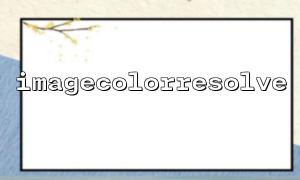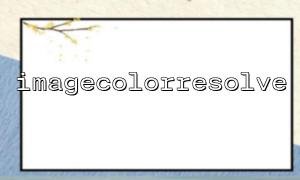There are some very powerful functions in PHP's image processing capabilities that can help us analyze, process and modify images. imagecolorresolve() is one of the commonly used functions, which is usually used to parse a specified color from an image and return the RGB value of that color. However, its behavior varies among different types of images, especially if the image is not a palette image, whether it still works properly is a topic worth discussing.
In this article, we will analyze how imagecolorresolve() handles non-palette images and explore whether it still works properly in true color images.
imagecolorresolve() is a function used to parse specified colors from an image resource. Its basic usage is as follows:
int imagecolorresolve ( resource $image , int $red , int $green , int $blue );
This function accepts three parameters: image resource $image and RGB color value to be parsed. It returns a boolean value indicating whether the color was successfully found. Returns true if a matching color is found, otherwise returns false .
Paletted Images : Each pixel of this type of image does not store a direct color, but an index value that points to a color table (palette). Palette images usually have fewer colors and are suitable for images with limited number of colors, such as GIF or PNG images.
True Color Images : Each pixel of a true color image stores a complete RGB value, that is, each pixel has its own color information. Common true color image formats include JPEG, PNG, BMP, etc.
For palette images, imagecolorresolve() works by looking for the presence of colors in the palette that matches the given RGB value. Because the palette image has a limited number of colors, it can quickly find the corresponding colors through indexing. Therefore, imagecolorresolve() works very efficiently in palette images.
For true color images, the situation will be different. Each pixel in a true color image contains complete RGB information, so imagecolorresolve() cannot find colors by indexing like in a palette image when processing these images. Despite this, imagecolorresolve() still works fine in true color images, but it may not work as intuitive as it is in palette images.
For true color images, imagecolorresolve() will determine whether there are pixels that match the given color value by traversing the RGB value of each pixel. If present, the function returns the index of that color (or its color ID). If it does not exist, return false .
Although imagecolorresolve() itself is more suitable for palette images, it can still be used in true color images, especially when dealing with scenes that need to find a specific color. Here is a simple example that demonstrates how to use imagecolorresolve() in a true color image:
<?php
// Loading the image
$image = imagecreatefromjpeg('image.jpg');
// The color value to be found
$red = 255;
$green = 0;
$blue = 0;
// Find the index of this color in the image
$found = imagecolorresolve($image, $red, $green, $blue);
if ($found) {
echo "Color found!";
} else {
echo "The color is not found in the image.";
}
// Release image resources
imagedestroy($image);
?>
In this example, we try to find pixels with RGB value in red in the image. Even though the image is a true color image, imagecolorresolve() can still check the RGB value of each pixel and tell us whether a matching color has been found.
imagecolorresolve() is a very useful PHP image processing function, but its performance varies by image type. For palette images, it can efficiently find colors by indexing, while for true color images, it needs to traverse the RGB values of each pixel to find matching colors. Nevertheless, imagecolorresolve() still works fine in true color images and can be used to find specific colors. It is important to note that if the image is very large, using this function can cause performance problems as it requires the image to be inspected pixel by pixel.
Hopefully this article can help you better understand the behavior of the imagecolorresolve() function in different types of images and can use it effectively to process colors in images.















